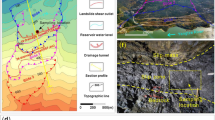Abstract
The loess-mudstone interface landslide is one kind of the loess landslides with special characteristics, such as continuous and low-rated deformation. Because of the relatively lower rate of deformation before the landslide initiated, the damage of this kind of landslides is always irreparable. In order to investigate the mechanism of loess-mudstone interface landslide and provide better controlling measures, triaxial tests and ring shear tests on the slip surface were carried out. It is aimed to analyze the shear strength characteristics of slip surface. Eight groups of consolidated undrained triaxial tests and five groups of consolidated drained ring shear tests were set. As the slip surface consisted of loess and weathered mudstone which is different from normal ones mostly containing the same material, there must be differences of shear strength characteristics between them. The results of the tests showed that the stress-strain curves of triaxial tests of the slip surface were significant strain-hardening, and the shear strength of slip surface is higher than that of pure loess but lower than the pure mudstone. The shear strength of the slip surface in ring shear tests increases with the growth of normal pressure. However, the shear stress of multistage ring shear test is much larger than the value of single-stage ring shear test. In conclusion, shear strength characteristics of slip surface in loess-mudstone interface landslide showed that this kind of landslides moved slowly but continuously. The stability of slip surface would be enhanced if the groundwater was prevented in time.
Access this chapter
Tax calculation will be finalised at checkout
Purchases are for personal use only
Similar content being viewed by others
References
Wu, W.J., Wang, N.Q.: Basic types and active features of loess landslide. Chin. J. Geol. Hazard Control 13(2), 36–40 (2002). (in Chinese)
Wu, W.J., Su, X., Liu, W., et al.: Loess-mudstone interface landslides: characteristics and causes. J. Glaciol. Geocryology 36(5), 1167–1175 (2014). (in Chinese)
Li, C., Yao, D., Wang, Z., et al.: Model test on rainfall-induced loess–mudstone interfacial landslides in Qingshuihe. China. Environ. Earth Sci. 75(9), 1–18 (2016)
Zhang, Z., Wang, T., Wu, S., et al.: Dynamics stress–strain behavior of Tianshui soils. Landslides 14(1), 323–335 (2017)
Su, H.L., Lee, S.J., Park, J.G., et al.: An experimental study on the characteristics of polyurethane-mixed coarse aggregates by large-scale triaxial test. Constr. Build. Mater. 145, 117–125 (2017)
Omar, T., Sadrekarimi, A.: Specimen size effects on behavior of loose sand in triaxial compression. Can. Geotech. J. 52(6), 732–746 (2014)
Ramaiah, B.J., Ramana, G.V.: Study of stress-strain and volume change behavior of emplaced municipal solid waste using large-scale triaxial testing. Waste Manag. 63, 366–379 (2017)
Le, N.H., Abriak, N.E., Binetruy, C., et al.: Mechanical behavior of municipal solid waste incinerator bottom ash: results from triaxial tests. Waste Manag. 65, 37–46 (2017)
Xing, A., Wang, G., Li, B., et al.: Long-runout mechanism and landsliding behaviour of large catastrophic. Can. Geotech. J. 52(7), 1–11 (2014)
Wang, G., Zhang, D., Furuya, G., et al.: Pore-pressure generation and fluidization in a loess landslide triggered by the 1920 Haiyuan earthquake, China: a case study. Eng. Geol. 174(1), 36–45 (2014)
Wang, G., Suemine, A., Schulz, W.H.: Shear-rate-dependent strength control on the dynamics of rainfall-triggered landslides, Tokushima Prefecture. Japan. Earth Surf. Process. Land. 35(4), 407–416 (2010)
Stark, T.D., Eid, H.T.: Drained residual strength of cohesive soils. J. Geotech. Eng. 120(5), 856–871 (1994)
Harris, A.J., Watson, P.D.J.: Optimal procedure for the ring shear test. Ground Eng. 30(6), 26–28 (1997)
Shibasaki, T., Matsuura, S., Hasegawa, Y.: Temperature-dependent residual shear strength characteristics of smectite-bearing landslide soils: temperature-dependent residual strength. J. Geophys. Res. Solid Earth 122(2), 1449–1469 (2017)
The Road Engineering Standards Policy Committee, BS1377–8. Methods of test for soils for civil engineering purposes–Part 8: Shear strength tests (effective stress). Business Service Innovation, England (1990)
Bishop, A.W., Green, G.E., Garga, V.K., Anderson, A., Brown, J.D.: A new ring shear apparatus and its application to the measurement of residual strength. Geotechnique 21(4), 273–328 (1971)
Chen, W.W., Liu, W., Lin, G.C., et al.: The study on sensitivity of landslide induced by changes in loess structure. J. Glaciol. Geocryology 38(4), 929–936 (2016). (in Chinese)
He, L., Wen, B.P.: Effect of lixiviation by irrigation water on undrained shear strength of weathered red mudstone in Northwest China. Hydrogeol. Eng. Geology 41(3), 47–52 (2014). (in Chinese)
Acknowledgements
Financial supports for this study were provided by the National Basic Research Program of China (2014CB744701), the opening fund of Key Laboratory of Loess Earthquake Engineering, China Earthquake Administration & Gansu Province (KLLEE-17-004) and The Central Universities (Grants No. lzujbky-2017-170). The valuable comments by the editor and referees of this paper are greatly appreciated. The authors want to thank all of the members who helped us and cooperated with us.
Author information
Authors and Affiliations
Corresponding author
Editor information
Editors and Affiliations
Rights and permissions
Copyright information
© 2018 Springer Nature Singapore Pte Ltd.
About this paper
Cite this paper
Liu, W., Chen, W., Lin, G., Wang, J., Sun, G., Zhong, X. (2018). Shear Strength of Slip Surface in Loess-Mudstone Interface Landslide. In: Zhou, A., Tao, J., Gu, X., Hu, L. (eds) Proceedings of GeoShanghai 2018 International Conference: Fundamentals of Soil Behaviours. GSIC 2018. Springer, Singapore. https://doi.org/10.1007/978-981-13-0125-4_59
Download citation
DOI: https://doi.org/10.1007/978-981-13-0125-4_59
Published:
Publisher Name: Springer, Singapore
Print ISBN: 978-981-13-0124-7
Online ISBN: 978-981-13-0125-4
eBook Packages: Earth and Environmental ScienceEarth and Environmental Science (R0)




